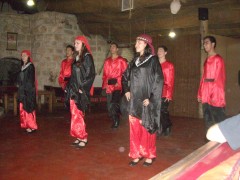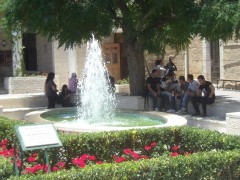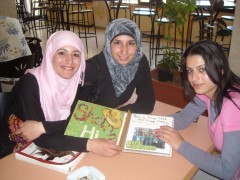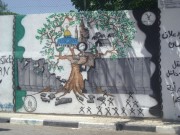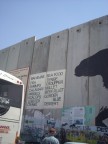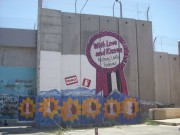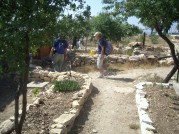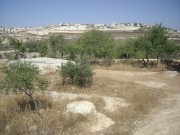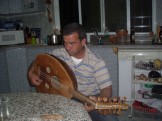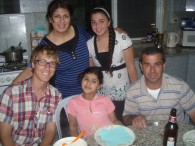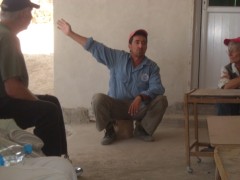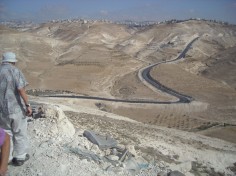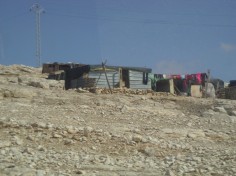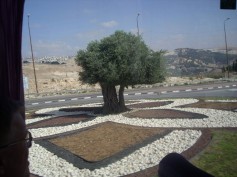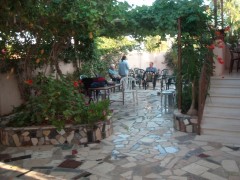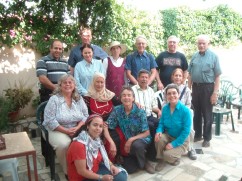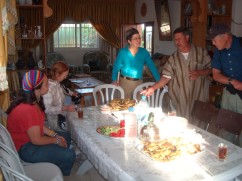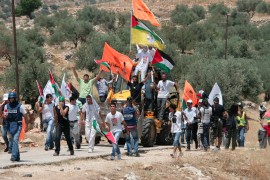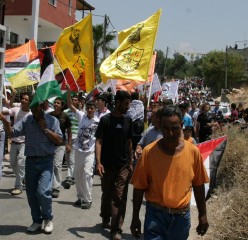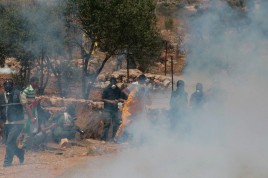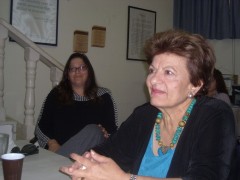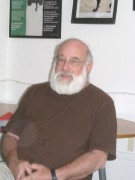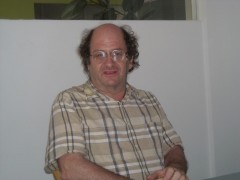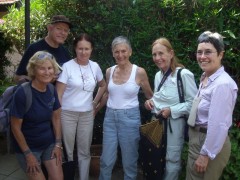My Trip to Palestine and Israel
Gaining Perspective in the Holy Land
A Neighbors East and West Travel Program in Palestine and Israel
Led By Dr. Tony Bing, Prof Emeritus, Earlham College
June 13 - 26, 2011
An Account by Sam Neff (samn@earlham.edu)
I think that if I ever go on another Mediterranean Vacation, it will be
somewhere else at some other time. I’ll happily return to
Slovenia, in the fall, or Capri in the Spring, or Dubrovnik anytime,
but not to Palestine and Israel in June, or any other summer
month. Anyone who has spent some part of his life reading and
believing the Bible should become acquainted with the geography and the
religious relics of the Levant, but in this day and age it should not
be necessary to see it in person in during the hottest driest time of
the year.
It is surprising that so many Pilgrims find this a good time of year to
travel through the Holy Land. I was amazed to see about 10 groups
of 50 tourists each, parading down the road to the (Catholic) Church of
the Annunciation, each led by a guide flying a numbered flag, and each
wearing a badge of the same number. I assume that the guides are
very careful to tell exactly the same story as their groups enter the
church, which the Catholics are sure is on the site where Mary
encountered the Angel Gabriel. Of course, the Orthodox Christians
have their own site.
-
The same large crowds were present at most of the Christian sites we
visited – often singing beautifully in ancient churches, or listening
raptly to convincing accounts of what happened here or there. I became
rather cynical at Yardenit,
a short arm of Lake Tiberius, formed by a
dam on the Jordan River. There I could observe pilgrims up to their
waist in water infested with catfish and hungry otters, in the shade of
biblically accurate Eucalyptus trees, wearing official and hygenic
white robes only available for rent or prchase at the concessions
near by.
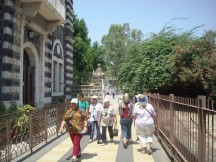
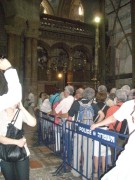
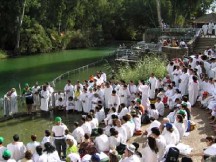 Crowds at Capernaum
Crowds at Church of Holy Sepulchre
Crowds at Yardenit (copied from net)
Crowds at Capernaum
Crowds at Church of Holy Sepulchre
Crowds at Yardenit (copied from net)
It is a shame that I reacted that way, since I do believe enough of the
bible to call myself a Christian. The garden site of the Mount of
the Beatitudes, overlooking the Sea of Galilee, is a good place to
contemplate that part of Jesus’ teachings, but I found myself
closed to that sort of thought by the constant commercialization that I
had encountered.
Yes, I did see holy places, and perhaps the very spot where Jehu ran
over Jezebel with his chariot, if he had one. But I had to do
that. Traveling to Palestine and Israel just to get a first-hand
look at the political situation, and to try to understand life on the
occupied West Bank is not an endeavor encouraged by the Israeli
authorities. Any tour agency – even a West Bank agency like
ours, must pay lip service to the pilgrimage idea, or else it may lose
its charter. For that reason we were careful not to carry an
itinerary of our trip when we entered Israel, and were told not to
mention the name of our guide if questioned on departure*.
*(Readers might note that a few weeks after our return, close to 100 travelers to Palestine and Israel, who
publicly showed their desire to participate in activities similar to ours on the West Bank, were labele by the Israeli
Authorities as“Hooligans” or "Terrorists", and sent to
jail, deported immediately, or both. For a personal account see http://www.sacc.org.uk/index.php?option=content&task=view&id=861&catid=52 Here is an excerpt:
"...The day after we arrived in the prison, a couple Border Police
officials visited the prison with an offer – initially to me:
‘For humanitarian reasons, you can go to Bethlehem if you sign a
document promising not to visit any place where there is conflict with
the Army.’ I asked, ‘Couldn’t there be conflict with
the Army anywhere?’ They clarified that the restriction meant
places such as Bil'in, Silwan, Jayous, etc....")
The travel group was typical of recent Neighbors East and West
assemblies – twenty-five participants from many parts of the US,
with the largest contingent coming from Montana. It included
three college students, five college professors, a couple of inveterate
wanderers, and a smattering of teachers and others. Quakers and
Unitarians were the dominant faith groups, though “none of the
above” enjoyed a good representation.
Not only were we from different places, we arrived from different
places and at different times. The meeting place was the El Beit Guest House
in Beit Sahour on the southern edge of Bethlehem. On the
appointed day (June 14) a few of the participants were already in
Israel, or at least near by. The remainder (minus four) arrived
at the Tel Aviv Airport at various times during the day and traveled on
to Beit Sahour. Plans were for everyone to arrive by dinnertime
that evening, and 80% succeeded. The full 100% of the group
(minus the one that never left home) were finally on the bus two days
later.
The trip was the idea of Ruth Neff, who was lucky enough to engage Tony Bing
as leader. Tony has been involved in the affairs of Palestine and
Israel since the early 80’s, when he began leading Earlham
College groups on a semester abroad program to the “Holy
Land”. In the course of his thirty-six visits, Tony has
developed a large body of contacts with concerned people in various
parts of Israel and Palestine. He felt that this could be his
last group, and as a result envisioned a program in which we would
encounter just about every one of his contacts. His ideas were
facilitated ably by George Ashwari and Iliana Khair Awad, and the
others at the Siraj Center
in Bethlehem. This was a full program, and not one for the faint
of heart. An easy day consisted of three meetings, two pilgrimage
sites and an hour of travel. A hard one was about double that.
As an example – the day we left
Nazareth (at 8 am) we toured Haifa and saw the Bahai Gardens.
Then we traveled on to Mount Carmel where Elijah is said to have
embarrassed the Priests of Baal. We had a program and lunch at
the previously unrecognized Muslim village of Ayn Hawd, and drove to
Tel Aviv. In Tel Aviv we met with Ruth Hiller of New Profile,
Adam Keller of Gush Shalom, and Amos Girvitz. We drove on to East
Jerusalem, where we arrived for dinner at the Holyland Hotel, just as
the dining room was closing. That’s three sites, four
meetings, three major cities and about 150 km on the bus for a 13
– hour day.
What follows is a sort of diary of my experiences, as I remember them, and some conclusions:
Day One – From Chicago to Beit Sahour:
Following three forgettable flights, we arrived in Tel Aviv around 2 pm
on the 14th. There we found a brave contingent of mostly
unfamiliar Americans holding signs saying “Neighbors East and
West”. In about an hour we were on a bus to Beit Sahour,
traveling over a modern, if winding freeway from Tel Aviv to Jerusalem
via the West Bank. There are no exits to the West Bank (except to
settlements) and no one who lives on the West Bank (outside the
settlements) is allowed to drive on this road. The Israeli
Supreme Court ruled that this road should be open to Palestinians and
Israelis, but the IDF disagrees.
Welcome to Israel.
We left Israel quickly and slowly assembled at the comfortable and welcoming El Beit Guesthouse.
The food was excellent and the rooms comfortable. We noted the
variable flush toilets, and did our best to conserve water in our
showers (wet, soap, rinse). We (nearly) met as a group for the
first time after dinner, and Will Boland joined us dramatically at about 10 pm –
he looked at Ruth and me and said “Must be the right
place.” He had traveled with us to Iran in 2009 and had been spending the previous two weeks in
Lebanon and Jordan.
Our first day in Bethlehem seemed full at the time, but in retrospect it was easy, and a good remedy for jet-lag. Mazin Qumsiyeh
gave us a thorough outline of the non-violent resistance activities of
the Palestinians, and then we went out to see the (Catholic)
Shepherd’s field. Beit Sahour means Shepherd’s Field,
and as no surprise several denominations have laid claims to the real
one.
* Personally, I think the real Shepherd’s Field is a section of every Christmas Pageant past, present and future,
but it has little connection to the dry sand of Beit Sahour.
What was most notable about the Shepherd’s Field we saw was not
the fairly modern chapel, or the caves in the hillside. What we
saw there for the first time was a hill-top Israeli Settlement, with
its boundaries steadily removing land from the Palestinians who lived
around it. This sight became familiar as our journey through the
West Bank continued.
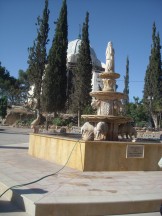
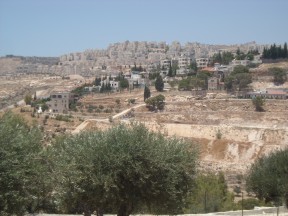 Franciscan Chapel at Shepherd's
Field,(1954)
Israeli Settlement in Distance
Franciscan Chapel at Shepherd's
Field,(1954)
Israeli Settlement in Distance
After lunch we met with a young community organizer at the Daheisha
Refugee Camp. He spoke accented English very rapidly, and with
jet-lag still in control it was hard to concentrate. Probably the
sights gave us a subjective montage of the camp. These included
the paved roads with hardly a patch of dirt, pictures of young
“martyred” men on the walls, a trophy case, small children
in various situations (walking in the street, looking out a car window,
peeking from a partially open door, following us as we wandered), and a
no-longer-used turnstile entry gate, into which camp residents have
thrown the keys to the homes from which they fled in 1948. Also
we could recognize the 12x12 concrete bunkers that were the first
permanent structures in the camp, replacing tents. Now they are
often the bottom floor of a three-story building housing the extended
families of the original residents.
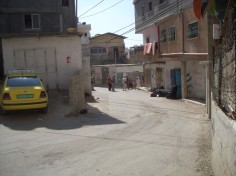
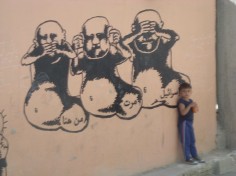
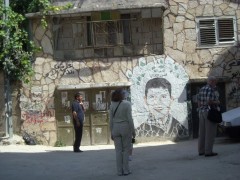
Old cement building in the center
graffiti and a
camp child a young martyr
We returned to the Siraj center for a meeting with Nora Korumi of Kairos Palestine, an ecumenical Christian organization working for peace and understanding between Arabs and Israelis. Her suggestions?
(1) End the Occupation
(2) Take every opportunity to enter into dialogue
(3) Speak to the Jewish people, and help them have a future in this land.
(We later heard Israeli Jews say often say that if the occupation and the settlement encroachment continues,
the Jewish People are going to lose Israel again.)
The day was not over – we had a “de-briefing”
followed by a dinner at the Grotto restaurant near the Shepherd’s
Field. The high-point was Debka Dancing by a troupe from the
Lutheran School in Bethlehem, with some participation by members of our
group.
The evening, and the morning, and the third day.
Today we
visited Bethlehem University
– it reminded me of a very good community college, with a a good business program but limited
curriculum in the sciences. It is a Christian (Catholic)
university – originally a commuter college, but now forced by the
occupation to provide housing for students.
The campus is
beautiful and well-kept, and the students, Muslim and Christian, bright
and lively like college students in many parts of the world. Bill
Harvey was pleased to find a first-class genetics research program
underway with support from the United States.
Later we saw the part of “The Wall” that snakes through
Bethlehem. We could only see the top of the old Byzantine Chapel called
Rachel’s Tomb, but we saw plenty of graffiti, and the menu of "The Wall" Restaurant.
We also visited the Tent of Nations
– the Daoud Nasser family’s stand in opposition to the settlement
on the hill.
It seemed ironic that after our stay at
the Tent of Nations, and our views of the settlement that is
threatening its existence, we encountered several Palestinian young men
waiting for a bus near where ours was parked. They were working
at that settlement.
We returned to the Siraj Center to meet our host families in Beit
Sahour. Ours was a Palestinian Christian family with two
daughters, and a son who is generally doted upon by the entire
family. He encounters very little discipline (the advantage of
being a single son). They also are hosting a young Canadian who
is working with an online “Youth Newspaper” in
Bethlehem.
Our next day in Hebron and the South Hebron Hills was tiring and
bizarre. We attended a presentation by the Hebron Restoration
Committee that highlighted their work to keep the old city a good place
for Palestinians to live. In the old city there are a few hundred
radical Jewish settlers living among 150,000 Palestinian
Muslims. In addition there are 2500 IDF protecting the
settlers. Seeing garbage-covered screens over Palestinian shops
(garbage thrown from the settlers’ windows above) and the
carefully guarded Jewish only streets was unsettling. We also
found out that the presence of the settlers and the IDF severely hampered
transportation and commerce around the old city. We missed seeing the Tombs of
the Patriarchs because it was Friday. That’s ok.
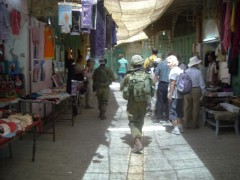

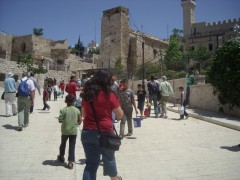 Israeli Soldiers in the Hebron Market
Trash Screens over the market
Another of Herod's
Palaces
Israeli Soldiers in the Hebron Market
Trash Screens over the market
Another of Herod's
Palaces
In the hills we visited the besieged village of Atuwani and talked with the Christian Peacemaker team
working there. More on that later.
Looking
at the Brownie Book
CPT Worker in Atuwani
A View
of the Village
We returned to Beit
Sahour to meet with a member of the Palestinian Parliament.
He impressed on us (to the extent that we could stay focused) the
importance to the government of the attempt to petition the United
Nations for the recognition of a Palestinian State. Many of those
who have talked to us have suggested that if that effort does not
receive good international support, it may mean the end of the Fatah
government. Then what?
The next two days, by comparison with the two previous ones, were
relaxing. We drove through the Valley of Fire, a steep, curvy
road around the settlement of Ma'ale Adumim which Palestinians must
drive to get from Bethlehem to Ramallah. The straight route is
not available, since it would have to cross Israeli-only roads.
Ironically USAID has spent a few million dollars to improve the Valley
of Fire road. I’m sure the Palestinians are thankful, since
that verifies that the US government considers the settlements quite
legal, and supports one aspect of Israeli Apartheid.
In Ramallah we visited members of the Quaker community at the meeting
house complex, and then went on to a short meeting with the head of the
Ramallah Friends School, now more than 100 years old. The
presence of well-watered shrubbery and trees made these areas
comfortable and cool-feeling, despite the regular temperatures near
90. The Friends School seems to be doing very well, and I am sure
serves a wealthy segment of the population. It does consciously
take needy students who can meet the school’s high standards.
We finished the day driving on to Bi’lin, expecting a rustic home
stay. We were wrong. The Bi’lin stay was comfortable
in many ways, and unlike many experiences on the trip, I look back on
it with pleasure. Our hosts were generous and gracious, and the
sleeping quarters like a penthouse . (The mattresses on the floor were
firm, but encouraged a good night’s sleep.)
We walked to the barrier and saw the debris remaining from four years
of non-violent demonstrations against it, and then spent much of the
afternoon simply enjoying the cool shade of the overhead grape
vines. It was memorable.
We traveled on to the north through the busy cities of Nablus and
Jenin, visiting some biblical sites and the strange and small Samaritan
community overlooking Nablus. We visited the Freedom Theater in
the Jenin Refugee Camp, and a cooperative that produces olive oil,
promoted in the US as a fair trade item.
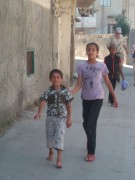
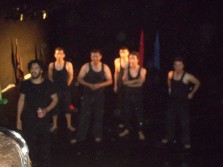
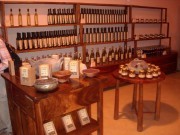
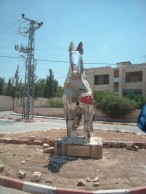 Jenin "Refugee" Children
Jenin Freedom Theater
Fair Trade Olive Oil
The Scrap Metal Horse
Jenin "Refugee" Children
Jenin Freedom Theater
Fair Trade Olive Oil
The Scrap Metal Horse
Then we traveled on to
the border crossing out of the West Bank on the road that led to Afula and
Nazareth. I was one of the ones chosen at the crossing to have my
luggage examined. Having a US passport seemed to be helpful
– Palestinians making the crossing were under careful
surveillance, even if their goods were just boxes of melons. The
border guards seemed to be mostly teen-agers, fulfilling their required
military service. One of them laughed a little when my harmonica
set off the metal detector. (He didn’t seem concerned by
the knife and flash drive I pulled out of the same pocket).
We had relaxing nights at the St. Margaret’s Hostel overlooking
the old city of Nazareth. The days, however, were typically busy,
although they were largely filled with visiting pilgrimage sites in
Galilee and Nazareth. We did travel to the northeast corner of
Israel to visit a destroyed Muslim village, and we met with a Christian
Israeli official whose comments were notably critical of West Bank
politics. The boat ride and swim in Lake Tiberius (aka the
Sea of Galilee) provided brief relief from the oppressive heat.
Eventually we embarked on that “impossible day” mentioned
earlier as we traveled from Nazareth to Jerusalem, and our final three
days were a mixture of pilgrimage sites, shopping and more meetings
mostly in the old city. On the 14th day of our journey many tired
Americans negotiated our way through Israeli Security to our flights
home.
No one asked if I had enjoyed my visit to the Holy Land. I am not sure how I would have answered.
In the waiting room we engaged in some short conversations with others
leaving – some Christian some Jewish. They refused to
believe what we told them we had experienced, and when critical of the
Israeli government, we were admonished on one occasion to “Think
like a Jew”.
General Observations:
We have taken trips to The Soviet Union, Yugoslavia, Bosnia, Cuba, Iran
and now Palestine / Israel with groups similar the one we led on this
one. Our goals in general involved making contact with people who
may be vilified by our home press, and learning about the physical
aspects and politics of the countries we are visiting. The
emphasis on these various aspects of our travel have varied, depending
on leadership and on the travel opportunities that the various
governments would allow. On this trip we were lucky to have
practically no government observing our activities, except at entry and
departure, and at the transit from Jenin to Nazareth. Of course,
the Israeli IDF was never far away, and in Hebron and East Jerusalem
they often seemed threatening.
So, what did we find? We were very comfortable with the Palestinian people as soon
as we stepped off the bus. Was that also true with Israelis? We
hardly met any Israelis casually. As a result I left the country with
the same stereotypes in my mind that I had when I arrived. We did
meet two Russian Israeli Jews – one of whom had met my brother
Charles in Moscow in 1958. They were friendly and relatively
normal, but neither had ever been to the West Bank (except to an
Israeli Settlement) because they were not allowed or because they
thought it would be too dangerous.
We did see Israelis. We saw nice enough Jewish children going to
some kind of a day camp or Sabbath school upstairs in an East Jerusalem
shopping area. I could only think that they were part of the
movement to force Palestinians out of the old city. We saw men
with beards and black top hats making their way determinedly to the
Western Wall, and I could only think of the fact that they do not serve
in the military, but, unlike “refuseniks”, get all the
benefits, anyway. “Paid to Pray” was what came to my
mind. We saw Israeli soldiers guarding the streets of Hebron for
the 500 settlers, who inhabit upper stories above the Palestinian
market and throw trash down on the streets below. It is strange
that I can start to form such anti-Israeli thoughts even though I have
gone to school, studued with and respected Jewish people all my life.
We also met with many Israelis from such organizations as Gush Shalom,
B’tselem, ICAHD, and New Profile, who raise questions about the
legality and sensibility of the current Israeli policy with regard to
Palestinians and the occupied territory. We also met with
Palestinians, Americans, and many Internationals who seemed to share
their views. Generally they blamed the occupation for the current
situation, and demand that it should end. Here are arguments that
we heard from all sides:
According to the Fourth Geneva Conventions:
1. Occupation by a foreign power should be short.
2. Those under occupation have a right to resist.
3. No territory should be acquired as a result of military force
4. An occupying power cannot colonize the occupied territory
5. Refugees from a conflict have a right to return to their original homes.
The Israeli occupation of the West Bank is illegal on all five of the above counts, and the settlements are as well.
Of course there is another view. The Israeli position is
basically that this is not a case to which the Geneva Convention
applies. This is not an occupation of the land of a hostile
government, since there is no recognized government in the West
Bank. This occupation is to provide security to Israel in the
face of a group of disorganized hostile individuals; therefore,
the Government of Israel is free to decide which actions to preserve
that security are justified. As far as settlements are concerned,
the Geneva Convention refers to “forced transfer” or
“deportation” to the disputed area, and does not involve
the voluntary settlement of people to that territory.
Furthermore, Article 80 of the UN Charter specifies that in any
disputed territory, there should be no infringement on the right of
people who have lived in that territory to remain there. Since
there have been Jewish people living in the West Bank throughout the
Zionist era, they have a perfect right to remain there (and I suppose,
invite their friends to join them.) That may be the idea behind
Bibi Netanyahu’s statement “…We have been building
in Jerusalem for 3000 years”.
The International Court of Justice has ruled that the settlements are
illegal, but that decision is strongly disputed roughly on the lines I
have outlined. (See the opinion piece by Eli Hertz at
http://www.israelnationalnews.com/Articles/Article.aspx/9290 )
Is that all there is to it? What is missing is the deep sense of
injustice which seems to capture most open minded people who become
acquainted with the situation in the West Bank. The Israeli
policy is laid out to obtain the most land while adding the fewest
(non-Jewish) people. As the occupying (but not really occupying)
power they have made the rules for land ownership on any piece of land
under their military or civilian control. Land in the West
Bank, for which the long-time inhabitants seem to have a legitimate
claim, can be confiscated for a variety of reasons. Here is an
incomplete list:
1. The land is needed to preserve Israeli Security
– thus settlements guard the valleys that lead into Israel.
The fact that these valleys contain good agricultural land and water
resources is a happy coincidence.
2. Individual Palestinians must prove ownership,
normally through deeds dating to the Ottoman period before WWI.
It was the practice, in the time of Ottoman Control, for a farmer to
register only part of his land, to keep taxes at a minimum.
Furthermore, grazing land near communities was used communally and
there was an understood collective ownership. This is a way for
Israel to take ownership of the good land, leaving the farmers with the
bit around their houses.
3. Even if there is evidence of ownership,
owners must show proof that they are using the land, or else it can be
taken over for better use. This is called the “Absent
Present” rule, or in my mind the “Oklahoma Law”.
4. It there happens to be some kind of Archeological
evidence of ancient Jewish habitation on the land, the government can
take it over as a historical site.
We can see how some of these rules play out.
I. Daoud Nasser’s land, “The Tent of
Nations”. Despite the fact that the Nasser family can show
clear ownership of the land from 1923 documents, the Israeli courts
continue to delay ruling on land ownership. The “Tent of
Nations” land is about 100 acres, covering a hilltop between two
Israeli Settlements among the string which seem destined to isolate
East Jerusalem from the West Bank. Despite the 10th commandment
Israel strongly covets this land. Since the ownership issue is
clear, and the Nassers continue to live on the property despite serious
access and water issues, “security” is the Israeli
“wedge”. Twice since 2005 the Nassers have been
threatened with building demolition, and with plans for security roads
to be built between the settlements. So far the Israeli courts
have put a hold on such action, but the pressure is always there.
The IDF may act anyway. The courts don’t always have the
power to stop the establishment of “facts on the ground”.
II. Atuwani, in the Hebron Hills. Atuwani is a
barren little village between the Israeli settlement of Ma’an and
the “illegal” outpost called Hill 933. In Atuwani is
the only primary school available to the children of surrounding
Palestinian villages, some of which are on the other side of the narrow
passageway between the two settlements. Once again Israel covets
the land of Atuwani, so that the two settlements can be joined and the
Palestinian land absorbed into their combined area. The plan then
would be to demolish the buildings of the village, including the
school. Here the first effort of the Israelis is to apply the
absent-present rule. Settlers have put out poison baits to
discourage the shepherds from grazing on the land – and if they
don’t use it (and prove that they are using it) they will lose
it. The settlers also have been known to harass children on the
road between the settlements so that they will not use the road to go
to school. (If they don’t use it …).
Atuwani’s plight has attracted Christian Peacemaker Teams –
“Internationals” who simply observe the actions of settlers
and IDF forces to be sure that the children are protected.
Because of Atuwani’s international notoriety, the inhabitants
have managed to maintain their precarious existence. However, we
noted that there were Israeli bulldozers excavating a site near the
center of the village. “Have they found anything?” Of
course – dig enough anywhere in the Levant and you probably will
find something, and if one shard looks Jewish, then it is a historical
site. The threat is always there.
III. Bi’lin Like Atuwani, Bi’lin
has attracted international attention. The route of the
well-known wall or barrier between Israel and the West Bank originally
cut off most of the agricultural land of Bi’lin from the village
itself. The route of the wall had been chosen to
“protect” an illegal settlement outpost much closer to
Bi’lin than the large settlement behind it. It was at least
10 km from the green line marking the internationally accepted Israeli
border.
(Note that name for this barrier in Hebrew is Geder HaHafrada, or
“separation barrier”. In Afrikaner that becomes the
“Aparteid” Wall.)
In 2007 the Israeli Supreme Court ruled that the wall had been
improperly routed, and established the compromise that Bi’lin
should get half its land back, and the outpost would become
legal. Well, half a loaf is better than none. However, the
IDF showed no inclination to implement the ruling, and for the past 5
years the people of Bi’lin have been demonstrating non-violently
in front of the barrier, and have been sprayed with tear gas, sewage,
and some rubber bullets.
6/24/2011
Non-Violent Demonstration in Bi'lin
The Israeli
Response
There also have been occasional forays
of the IDF into Bi’lin. We saw the results – we could
pick up spent tear-gas canisters, and smell the fluids that had been
sprayed on the demonstrators. We also saw that hundreds of the
olive trees in between the new and old routes of the barrier had been
burned to the ground. Is my anger justified?


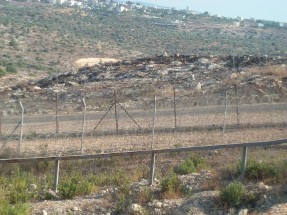 Spent Tear-Gas Canisters
Bi'lin Resident and One of his Trees
The Remains of his Trees Beyond the Fence
Spent Tear-Gas Canisters
Bi'lin Resident and One of his Trees
The Remains of his Trees Beyond the Fence
Just as we left Israel we found out that the Supreme Court decision was
being implemented, and in the US papers it was described as a victory
for the inhabitants of Bi’lin. As Pyrrhus said –
“One more such victory …”
IV. Near Kafr Yasif, in the northwest corner of
Israel, we observed the remains of a village which underwent a forced
evacuation (for security reasons) in 1948. The inhabitants, all
Muslim, moved to Kafr Yasif to wait to return to their homes.
When they tried to return, the Israeli army responded by bulldozing
every building except the mosque. What remains now is the rubble
of many destroyed homes, amid a plantation of pine trees, and
occasional lines of prickly-pear cactus which mark the old property
lines.

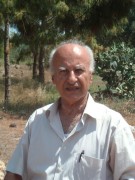 Mosque, Standing but closed to
Worship
Daoud, who was born here
Mosque, Standing but closed to
Worship
Daoud, who was born here
V. In the hills not far from Mount Carmel, south of
Haifa, there is a small Palestinian Muslim town of `Ayn Hawd
al-Jadida. Below it is the Israeli Artist Colony called by a
similar but “Hebrewized” name, Ein Hod.
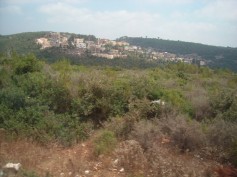
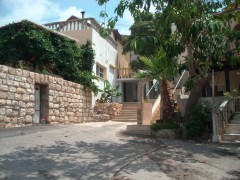
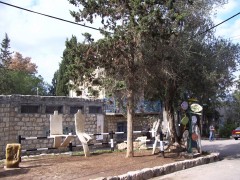 'Ayn Hawd from a
Distance
In 'Ayn Haud
Ein
Hod, Israeli Artist Colony
'Ayn Hawd from a
Distance
In 'Ayn Haud
Ein
Hod, Israeli Artist Colony
The colony
exists in the homes of the Palestinians who live above them. The
artists extol the rustic and ancient qualities of their town, and even
praise life without electricity. Above them the Palestinians must
generate their own electricity and count on only a provisional supply
of water (and no other services) because their village is not
recognized. Somehow, over the past 63 years they have survived
being absent/present, recognized/unrecognized, and under demolition
order, and cling to a precarious existence. The situation can be
described as “An invisible reality moving phantomwise
beneath a visible fiction”.
We were there for a showing of a video describing the history of the
village. I believe it was the documentary “500 Dunams on
the Moon” by Rachel Leah Jones. Afterwards we enjoyed a
sumptious if expensive meal at the town’s restaurant. We
were not the only international group making this kind of pilgrimage to
`Ayn Hawd. This was their way of keeping the village in the minds
of people outside of Israel, and avoiding demolition through
embarrassment.
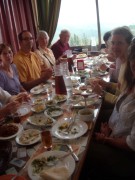 What a Meal!
What a Meal!
“Ayn Hawd and the "Unrecognized Villages” Muhammad Abu al-Hayja' with an introduction by Rachel Leah Jones
Journal of Palestine Studies, Vol. 31, no. 1 (Autumn 2001), p. 39
For a pdf version of the full article click here,
VI.The Augusta Victoria Hospital in East Jerusalem is not a village,
but it is another threatened Palestinian institution. Its 47
acres of land is on a hill top not far from the Hebrew University in
West Jerusalem. The building was originally built by Kaiser
Wilhelm as a power center for Germans in Jerusalem. Some time
after WWI it was given to Lutheran World Federationnmand converted to a
hospital. It now provides “Tertiary” care to
Palestinians, and houses modern medical devices such as two linear
accelerators for Cancer radiation therapy. It is the only
Palestinian Hospital that can provide high-level treatment.
Israel limits its effectiveness by invoking travel restrictions on
patients who must cross through checkpoints to reach the
hospital.
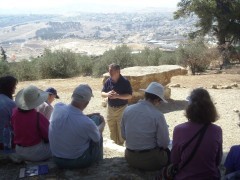
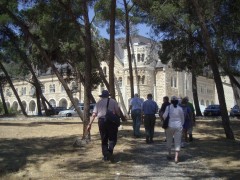 Mark Brown, Hospital Director, Speaks
to Group
Augusta Victoria Hospital
Mark Brown, Hospital Director, Speaks
to Group
Augusta Victoria Hospital
As I go through these examples, I become angry at the injustice and
long for a modern-day Amos to speak to the Israeli people.
Perhaps many of the Israelis whom we met are trying their best to fill
that role, but as with most prophets, they are barely heard in their
own country.
To me, the injustices of the present situation are
clear and blatant – the official Israeli explanations, even
though they are convincing to our legislators, are crafted from a
technical reading of international law, with clear disregard for
intent.
Like many others, I see a close similarity between the steady
accumulation of land without people by Israel in the West Bank to be
similar to the settling of the Western United States in the last part
of the 19th century. I read historical books on that era,
hoping that I will find a new ending. It is a sign of insanity.









